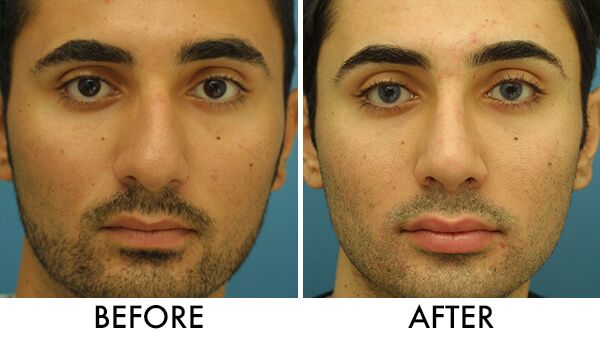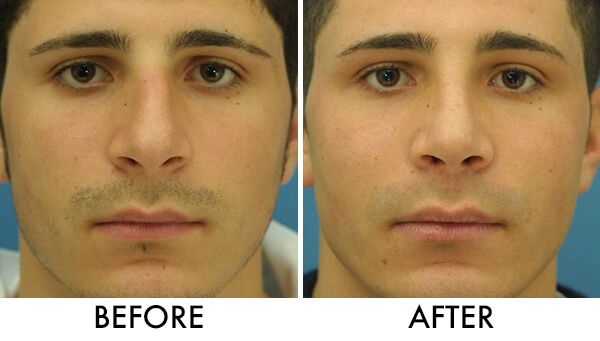Surgical & Non-Surgical Options For Correcting A Crooked Nose

Facial symmetry plays a very important role in how the mind perceives beauty. While it’s estimated that 97% of people have some degree of facial asymmetry, severe asymmetry can distort the overall aesthetic of the face.
Due to its prominence, the nose plays a vital role in determining how symmetrical the face appears. Thus, a crooked nose negatively impacts the appearance of the entire face.
What is a Crooked Nose?
A crooked nose is one that features some degree of a curvature rather than following a straight vertical line down the center of the face. Crooked noses can vary in terms of severity, from barely noticeable to dramatically prominent. While some curvatures are only a cosmetic concern, many instances of a crooked nose can result in some form of breathing obstruction.
The bridge of your nose should follow a straight line from your brow area to the tip. The deviation from a straight line may be barely noticeable or obvious. There are three classifications for crooked noses, depending on the deviation:
- A C-shaped nose is curved like a “C” or reverse “C” to the right or left.
- An I-shaped nose is generally straight, yet the line from the brow ends just off-center of the tip.
- A person with an S-shaped nose is deviated to one side in the upper half of the nose, then to the other on the lower half.
What Causes a Crooked Nose?
The root cause of a crooked nose stems from issues relating to the cartilages, bones, and other tissues that make up the nose. This underlying scaffolding determines the appearance of the nose. The most common issue that alters the structure of the nose is some sort of trauma or injury (i.e. a broken nose). Other potential issues include birth defects, prior surgeries in the area, or tumors.
In some cases, a deviated septum can also impact the appearance of the nose to the point where it appears crooked. The septum is the internal partition wall that separates the nasal passages from each other. The top of the septum is the top of the nose. A deviated septum occurs when this wall leans over to one side, blocking that nasal passage. If the deviation extends to the top, the external nose will appear crooked. In some cases a deviated septum may cause frequent bloody noses. When severe, the deviation will block airflow and/or alter the appearance of the nose.
Can Exercises Fix a Crooked Nose?
There are numerous online resources preaching various facial exercises dedicated to fixing a crooked nose. While nose straightening exercises may sound intriguing, they simply will not work. This is because the nose is made up of bones and cartilages that will be unaffected through any type of exercise.
What Treatment Options Can Correct A Crooked Nose?
There are several effective treatment options, both surgical and non-surgical, for addressing a crooked nose. The most important factor in selecting the right treatment option is to understand the specific causes of the crooked nose. A skilled surgeon will assess the nose in order to determine and advise on the best course of treatment.
Dermal Fillers (Liquid Rhinoplasty)
In some cases, dermal fillers such as Restylane can be used to correct a crooked nose. Sometimes referred to as “liquid rhinoplasty”, dermal filler injections can sometimes reshape the nose without the need for surgery. This option is 100% non-surgical, minimal discomfort, and requires no downtime. However, the results a liquid rhinoplasty provides are temporary and patients will need to undergo annual treatments in order to maintain their look.
Rhinoplasty
Rhinoplasty (nose surgery) is a plastic surgery procedure dedicated to altering the shape and/or size of the nose in order to enhance its appearance relative to the rest of the face. Rhinoplasty procedures can be classified as strictly cosmetic if the procedure is solely performed to enhance the appearance of the nose, or as “functional” if the procedure is performed to correct the function (breathing issues) of the nose. Cosmetic and functional rhinoplasty are often performed together. Functional rhinoplasty always includes septoplasty. Learn more about rhinoplasty for correcting a crooked nose.
Septoplasty
Septoplasty is a surgical procedure dedicated to reshaping the septum, the wall between the left and right nasal passage. The procedure can correct a deviated septum and improve air flow through a previously blocked nasal airway. When the top of the septum is deviated it creates a crooked nose, so it must be straightened at the same time with functional rhinoplasty. When a septoplasty is performed in conjunction with a rhinoplasty it is referred to as a “septorhinoplasty”.
Case 1: Before & After I-Shaped Nose Correction

Case 2: Before & After C-Shaped Nose Correction

Case 3: Before & After S-Shaped Nose Correction

The Difficulties of Correcting a Crooked Nose
Correcting a crooked nose is one of the more difficult forms of cosmetic nose enhancement for several reasons. First, most patients have other facial asymmetries which can make achieving a perfectly straight nose impossible. Although the surgery will improve how straight the nose looks, it may not be able to straighten it completely. This is why it’s so important for patients to select board certified surgeon who has specific experience addressing crooked noses.
Secondly, cartilage has a form of “memory” which can affect how straight the nose remains as it heals post-procedure. While the nose may be straight after surgery, the cartilage sometimes tries to move back to its original (curved) positioning. If trauma or previous surgery has contributed to the deviation, then the scar from those events makes cartilage straightening even more difficult. Various techniques employed during surgery can minimize the risk or re-deviation; the more experienced the surgeon, the less the risk of postoperative deviation. Very experienced surgeons have revision rates of less than 5% in primary cases, meaning that after one year of healing the likelihood of success is over 95% when it comes to both the function and the appearance of the formerly crooked nose.
How Does Rhinoplasty Correct a Crooked Nose?
Rhinoplasty is performed for cosmetic and functional reasons. From an aesthetic perspective, the procedure aims to correct the curvature of your nose. Almost all crooked noses also have a component of a deviated septum. Since septoplasty is almost always needed to correct an external deviation (since the two are so closely tied), a rhinoplasty surgeon must be skilled in both septoplasty and rhinoplasty.
Benefits of Rhinoplasty for a Crooked Nose
Since a crooked nose is due not only to a deviated septum, but also to nasal bone deviations and external cartilage deviations, rhinoplasty addresses all the components that are crooked: bones, cartilages and septum. This should not only straighten your nose but improve your breathing if the deviation affects the septum and internal nasal valves (where the septum and cartilage sidewalls meet on the inside of the nose).
Who is an Ideal Candidate for the Procedure?
If you are bothered by the crooked shape of your nose, rhinoplasty may be right for you. It is also ideal for people who have a deviated septum that affects nose shape and size, as well as the ability to breathe and clear your sinuses. The surgery is performed under general anesthesia, and you should be in good overall health.
How is Rhinoplasty for a Crooked Nose Performed (Nose Straightening Surgery)?
An individual treatment plan is developed for your nose straightening procedure. The two primary approaches to rhinoplasty are using a closed or open technique. The closed technique involves making incisions inside your nose, and it is typically recommended for straightening a nose that is slightly crooked. For people who require more involved corrections, an open technique is a preferred approach. This involves making an incision in the skin under the nose between your nostrils and exposing the interior of your nose. Repairing your crooked nose may involve reshaping, removing, or adding bone and cartilage.
Do the Bones Have to Be Broken and Reset?
In most crooked nose cases, cutting the bones and mobilizing them to a straighter position allows your nose to heal with a more appropriate shape. Resetting the bone gives your nose a straighter, more symmetrical appearance.
How Long Does It Take to Recover?
The rhinoplasty recovery experience can differ greatly from patient to patient. The initial healing after rhinoplasty surgery takes up to seven days, and you will need to rest during this time. Expect to have swelling, bruising, severe nasal obstruction, and some discomfort. You may have bruising and swelling around your eyes. Non-prescription and/or prescription pain medication helps you feel comfortable. Avoid blowing your nose, and it may be more comfortable to breathe through your mouth. Bruising may last up to 10 days; swelling is not noticeable to others after two or three weeks.
Soft tissues tend to heal first, and this is when you may notice a scar line if an external incision has been made. Initially, the scar is slightly pink, and it changes to a color that is slightly darker than the surrounding skin. The bones of your nose are stable in approximately six weeks.
You can return to more strenuous activities after three to four weeks. As your nose heals, it is important to take extra precautions to protect it. If the bones and cartilages do not heal correctly, you may need a revision rhinoplasty procedure.
Will Medical Insurance Cover Crooked Nose Correction?
Unfortunately, most medical insurance polies will not cover external nose correction as they will often be deemed as cosmetic and not medically necessary. In certain cases, functional rhinoplasty may be covered by insurance if the procedure is performed to correct a breathing issue. Since insurance policies can vary, we recommend contacting your insurance carrier to verify coverage.
Disclaimer: The contents of the Westlake Dermatology website, including text, graphics, and images, are for informational purposes only and are not intended to substitute for direct medical advice from your physician or other qualified professional.

Thank you very much for a very helpful article! I always wanted to straighten your nose for cosmetic reasons not that Im having problems breathing. I want to enhance the shape of my nose I feel that by doing that it will boost my confidence and well being. Very helpful!
Amazing article and good information! I have a pretty crooked nose stemming from trauma (hockey player here). Thanks for laying this all out
very helpful post, thanks for sharing.
I had rhinoplasty 6 weeks ago , resulting in an S- shaped crooked nose. I did everything that I was instructed to do after the procedure; wore the external and internal splints, was careful not to injure my nose, slept upright, did not exercise. When I went for my follow up , after looking at my nose, she states that this was the result of bone formation after the break and suggested fillers. How did this happen?? Is there a possibility that my nose will straighten after time?
I am devastated!
Would you be able to show me pictures of how fillers have improved the appearance of S shaped crooked nose? Need help
Thank you
Hi Rosalie,
Sorry to hear about this issue, but we greatly appreciate you sharing with our audience. I spoke with Dr. Constantinides and here is his reply:
I am so sorry to hear about what you’re going through. 6 weeks is very early after surgery, and what you are seeing will still change as swelling goes away. I don’t recommend fillers after rhinoplasty for at least 3 months, and usually not for 6 months or more. Once you have healed completely, have an earnest talk with your surgeon. If you are still crooked, revision surgery may help. You trusted your surgeon to give you a nice result. Trust her now to help you get through this early healing and, if needed, fix it later.
We hope that helps!
Thanks,
WD Staff
I think I messed up my nose more after surgery.
Hi Rohman,
We’re sorry to hear that. The nose is definitely very fragile post-procedure. We would recommend you reach out to your surgeon, they may ask you to come in for an in-person assessment.
We hope that helps!
Thanks,
WD Staff
What’s the cost of straightening the crooked nose ?
Hello,
Great question. Rhinoplasty cost can range from $6,000 to $12,000 depending upon patient need, experience level of surgeon, and geographic location. Here’s a great post on cost ranges of rhinoplasty by city: https://www.westlakedermatology.com/blog/cosmetic-treatments-cost-guide/#rhinoplasty
As always, you’ll need to get an in-person consultation to find the true cost of the procedure for your individual needs and goals.
Thanks,
WD Staff
I have a severe I-shaped crooked nose, very similar to the guy pictured above with the blue background, very obviously crooked. I went to a plastic surgeon and he tried to convince me that my nose wasn’t crooked and all he had to do was shave down the one side, the side that it leans toward, which by that thought process being that it’s so crooked he would have had to “shave” the bridge all the way over to the other side of my nose essentially removing the bridge in order for it to be straight, and then the top of the nose would still look like the man’s pictured above! I would really appreciate a recommendation of the absolute best rhinoplasty surgeons in America, regardless of cost or location if you have any. I seen a webinar many years ago done by a surgeon in Dallas I believe who was showing other surgeons how to use the patients rib cartilage to straighten the nose and assumed I would need some extensive work from a specialist like that. Anyway, appreciate any info you could provide, have a nice day.
hello ,
my name is harry and my age is 22 .i didn’t got any injury or fracture on my nose. My nose was straight till age 19 but at the age 20 it bent without any reason..I am not suffering from any breathing issues and no other issues with my nose but it was killing my confidence among others what to do?
Hi Harry,
We are sorry to hear about this issue, but appreciate you leaving the comment for our readers. It is possible to experience unwanted bending of the nose without any injury or impact to the area. Fortunately there are many different types of rhinoplasty techniques to address the issue. If you are not experiencing any breathing issues, you may want to look into a cosmetic rhinoplasty procedure. We recommend finding a board certified plastic surgeon in your area that has expertise in cosmetic nose surgery. Definitely see a few providers for an in-person consultation to discuss what the procedure will do for your specific needs.
We hope that helps!
Thanks
WD Staff
Due to a break about 25 years ago, then another five years ago, my nose has a c-curve equal to perhaps 1/4 of the bridge width. My bathroom mirror, which is where I always see myself except very rarely, is extremely flattering to anyone in front of it due to good lighting, but when I saw photographs of myself recently taken by someone else, I was appalled. I now realize that in regular lighting conditions it’s decidedly a mess.
As I contemplate taking steps to improve (or rather, restore) my nose, I am concerned that my anatomy underneath will present a major problem. When two years ago I had a bit of a scare over a possible stroke (it turns out I didn’t have one) I had an image scan done, which I later saw myself. I was surprised to see just how much my sinuses swerve off to one side as they leave my nose and go further into my head.
Does a pronounced deviation from the medial line ordinarily present a big challenge in a rhinoplasty to correct a c-curve?
Hi Harry,
Thanks for asking this great question! I spoke with Dr. Constantinides and here is his reply:
“Thank you for your question. It sounds like you not only have an external deviation, but also an internal deviation of the septum. This is very common and does not in and of itself present a prohibitive challenge for a skilled rhinoplasty surgeon. Your best option would be to seek a consultation, where your surgeon will be able to examine you and let you know what particular challenges your nose presents. I hope that helps.”
Thanks,
WD Staff